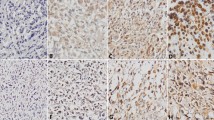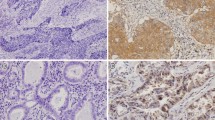Abstract
Background
Osteopontin (OPN) is a secreted, integrin-binding glycophosphoprotein that has been implicated in the progression of various solid tumors. To evaluate the clinical significance of OPN in gastric carcinoma, we investigated OPN expression in resected tumors.
Methods
Expression of OPN protein by gastric cancer cells was evaluated using western blot analysis. OPN messenger RNA (mRNA) expression in 18 gastric cancers was compared with that in the corresponding normal gastric epithelium by semiquantitative reverse transcription polymerase chain reaction (RT-PCR). Paraffin sections of tumors from 295 patients with gastric cancer were also investigated using immunohistochemistry.
Results
All four gastric cancer cell lines analyzed using western blotting had almost the same level of OPN protein expression as the positive control (HeLa cells). OPN mRNA was upregulated in 83% (15/18) of the tumors studied. On immunohistochemical staining, 90 tumors were classified as negative (−), whereas 205 were classified as positive (1+, 2+, or 3+). The level of OPN protein expression was significantly associated with the patient’s age (p = 0.04), tumor depth (p = 0.03), histological grade (p = 0.008), and hematogenous metastasis (p = 0.007). Kaplan–Meier analysis showed that OPN positivity was significantly associated with a shorter survival time (p = 0.027). Furthermore, multivariate analysis revealed that OPN positivity was an independent risk factor for hematogenous metastasis (p = 0.034).
Conclusions
The present findings suggest that increased tumor expression of OPN is an important determinant of shorter survival time and that OPN positivity may be useful for predicting the risk of hematogenous metastasis in gastric cancer patients.






Similar content being viewed by others
References
Shimada Y, Yamasaki S, Hashimoto Y, et al. Clinical significance of dysadherin expression in gastric cancer patients. Clin Cancer Res 2004;10:2818–23
Duff SE, Li C, Jeziorska M, et al. Vascular endothelial growth factors C and D and lymphangiogenesis in gastrointestinal tract malignancy. Br J Cancer 2003;89:426–30
Senger DR, Wirth DF, Hynes RO. Transformed mammalian cells secrete specific proteins and phosphoproteins. Cell 1979;16:885–93
Senger DR, Perruzzi CA. Secreted phosphoprotein markers for neoplastic transformation of human epithelial and fibroblastic cells. Cancer Res 1985;45:5818–23
Behrend EI, Craig AM, Wilson SM, Denhardt DT, Chambers AF. Reduced malignancy of ras-transformed NIH 3T3 cells expressing antisense osteopontin RNA. Cancer Res 1994;54:832–7
Oates AJ, Barraclough R, Rudland PS. The role of osteopontin in tumorigenesis and metastasis. Invasion Metastasis 1997;17:1–15
Weber GF. The metastasis gene osteopontin: a candidate target for cancer therapy. Biochem Biophys Acta 2001;1552:61–85
Das R, Mahabeleshwar GH, Kundu GC. Osteopontin stimulates cell motility and nuclear factor kappa B-mediated secretion of urokinase type plasminogen activator through phosphatidylinositol 3-kinase / Akt signaling pathways in breast cancer cells. J Biol Chem 2003;278:28593–606
Crawford HC, Matrisian LM, Liaw L. Distinct roles of osteopontin in host defense activity and tumor survival during squamous cell carcinoma progression in vivo. Cancer Res 1998;58:5206–15
Ye QH, Qin LX, Forgues M, et al. Predicting hepatitis B virus-positive metastatic hepatocellular carcinomas using gene expression profiling and supervised machine learning. Nat Med 2003;9:416–23
Agrawal D, Chen T, Irby R, et al. Osteopontin identified as lead marker of colon cancer progression, using pooled sample expression profiling. J Natl Cancer Inst 2002:94:513–21
Khodavirdi AC, Song Z, Yang S, et al. Increased expression of osteopontin contributes to the progression of prostate cancer. Cancer Res 2006;66:883–8
Forootan SS, Foster CS, Aachi VR, Adamson J, Smith PH, Lin K, Ke Y. Prognostic significance of osteopontin expression in human prostate cancer. Int J Cancer 2006;118:2255–61
Singhal H, Bautista DS, Tonkin KS, O’Malley FP, Tuck AB, Chambers AF, Harris JF. Elevated plasma osteopontin in metastatic breast cancer associated with increased tumor burden and decreased survival. Clin Cancer Res 1997;3:605–11
Saitoh Y, Kuratsu J, Takeshima H, Yamamoto S, Ushio Y. Expression of osteopontin in human glioma. Its correlation with malignancy. Lab Invest 1995;72:55–63
Devoll RE, Li W, Woods KV, Pinero GJ, Butler WT, Farach-Carson MC, Happonen RP. Osteopontin (OPN) distribution in premalignant and malignant lesions of oral epithelium and expression in cell lines derived from squamous cell carcinoma of the oral cavity. J Oral Pathol Med 1999;28:97–101
Kim JH, Skates SJ, Uede T, et al. Osteopontin as a potential diagnostic biomarker for ovarian cancer. J Am Med Assoc 2002;287:1671–9
Hotte SJ, Winquist EW, Stitt L, Wilson SM, Chambers AF. Plasma osteopontin: association with survival and metastasis to bone in men with hormone-refractory prostate carcinoma. Cancer 2002;95:506–12
Schneider S, Yochim J, Brabender J, et al. Osteopontin but not osteonectin messenger RNA expression is a prognostic marker in curatively resected non-small cell lung cancer. Clin Cancer Res 2004;10:1588–96
Le QT, Sutphin PD, Raychaudhuri S, et al. Identification of osteopontin as a prognostic plasma marker for head and neck squamous cell carcinomas. Clin Cancer Res 2003;9:59–67
Pan HW, Ou TH, Peng SY, et al. Overexpression of osteopontin is associated with intrahepatic metastasis, early recurrence, and poorer prognosis of surgically resected hepatocellular carcinoma. Cancer 2003;98:119–27
Shimada Y, Watanabe G, Kawamura J, et al. Clinical significance of osteopontin in esophageal squamous cell carcinoma: comparison with common tumor markers. Oncology 2005;68:285–92
Ito T, Hashimoto Y, Tanaka E, et al. An inducible shRNA vector against osteopontin reduces cell motility, tumor formation, and lymph node metastasis of human esophageal squamous cell carcinoma. Clin Cancer Res 2006;12:1308–16
Ue T, Yokozaki H, Kitadai Y, Yamamoto S, Yasui W, Ishikawa T, Tahara E. Co-expression of osteopontin and CD44v9 in gastric cancer. Int J Cancer 1998;79:127–32
Lee S, Baek M, Yankg H, et al. Identification of genes differentially expressed between gastric cancers and normal gastric mucosa with cDNA microarrays. Cancer Lett 2002;184:197–206
Uchida S, Shimada Y, Watanabe G, et al. In oesophageal squamous carcinoma vascular endothelial growth factor is associated with p53 mutation, advanced stage and poor prognosis. Br J Cancer 1998;77:1704–9
Cox DR. Regression models and life tables. J R Stat Soc (B) 1972;34:187–220
Ino Y, Gotoh M, Sakamoto M, Tsukagoshi K, Hirohashi S. Dysadherin, a cancer-associated cell membrane glycoprotein, down-regulates E-cadherin and promotes metastasis. Proc Natl Acad Sci USA 2002;99:365–70
Nemoto H, Rittling SR, Yoshitake H, et al. Osteopontin deficiency reduces experimental tumor cell metastasis to bone and soft tissues. J Bone Miner Res 2001;16:652–9
Moriguchi S, Kamakura T, Odaka T, Nose Y, Maehara Y, Korenaga D, Sugimachi K. Clinical features of the differentiated and undifferentiated types of advanced gastric carcinoma: univariate and multivariate analyses. J Surg Oncol 1991;48:202–6
Acknowledgements
The authors thank Mrs Sakiko Shimada for her technical assistance with the immunohistochemistry studies. The authors also thank Mr Jonathan Broome for his support in proofreading the manuscript. This work was supported in part by a grant-in-aid from the Japanese Ministry of Education, Culture, Sports, Science and Technology (Grant 14370385).
Author information
Authors and Affiliations
Corresponding author
Rights and permissions
About this article
Cite this article
Higashiyama, M., Ito, T., Tanaka, E. et al. Prognostic Significance of Osteopontin Expression in Human Gastric Carcinoma. Ann Surg Oncol 14, 3419–3427 (2007). https://doi.org/10.1245/s10434-007-9564-8
Received:
Revised:
Accepted:
Published:
Issue Date:
DOI: https://doi.org/10.1245/s10434-007-9564-8




